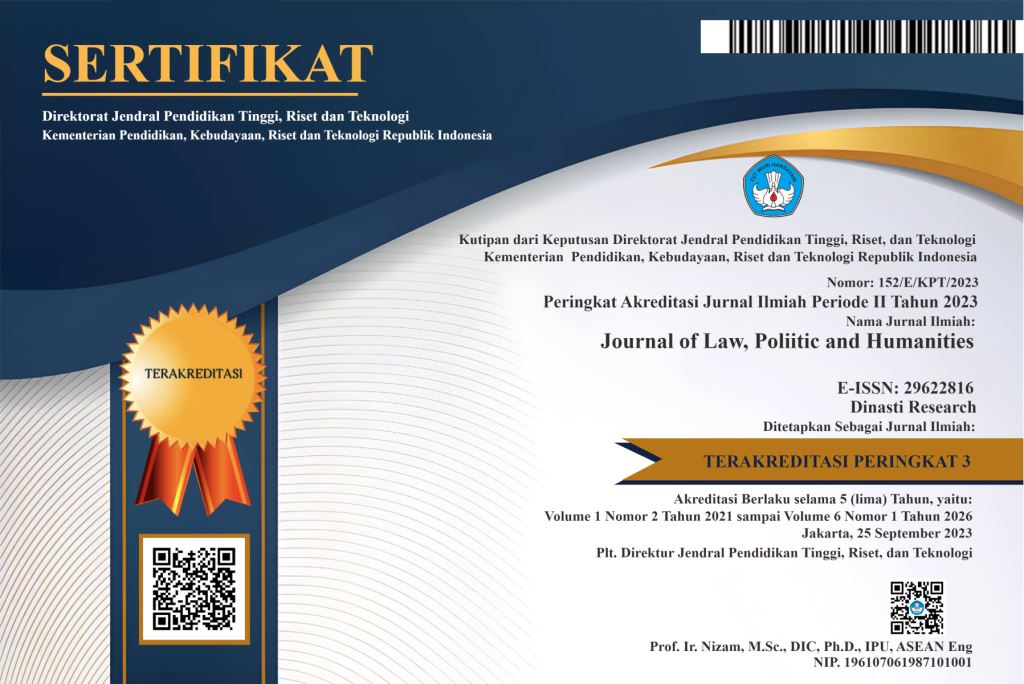Agricultural Land Control Based on the Regulation of the Minister of Agrarian and Spatial Planning/ Head of the National Land Agency of the Republic of Indonesia Number 18 of 2016 Concerning Control of Agricultural Land Tenure
DOI:
https://doi.org/10.38035/jlph.v5i4.1617Keywords:
Control, Regulations, Agricultural LandAbstract
The goal of managing Agricultural Land Tenure is to regulate the utilization of agricultural land for purposes other than agriculture, such as housing or other activities. This is a problem, what if a citizen has land with agricultural status, then there are many things that have to go through until it can be divided and sold to other parties. The problem of dividing agricultural land is approached through compliance with the Regulation of the Minister of Agrarian Affairs and Spatial Planning/Head of the National Land Agency of Indonesia Number 18 of 2016, which dictates the legal repercussions of not following the Site Plan provided by local governments. This research takes a normative perspective, concentrating on the process of agricultural land disappearing based on the mentioned rule. The goal is to stop the transformation of agricultural land into housing developments. The rule also requires that any changes be sent to the local RT RW district/city and then forwarded to the Ministry of Land and Spatial Planning. This rule is based on the Minister of Agrarian Affairs and Spatial Planning/Head of BPN Decree Number 1589/SK-HK.02.01/XII/2021, which deals with the Mapping of Protected Rice Fields (LSD) in Regencies/Cities. If the separation of agricultural land does not follow the site plan provided by the local governments, there may be legal consequences. Based on an analysis of the theory of authority, this violation would likely be rejected as the use of the set plan is compulsory for dividing land plots exceeding 5 plots and agricultural land.
References
Anitasari, R. F. (2019). Agrarian Law: Perspective of Indonesian Agricultural Policies. South East Asia Journal of Contemporary Business, Economics and Law, 20(4).
Ansori, A. J. (2024). Legal Overview of Compensation for Land in the Development of PT. PLN’s Sutet Tower Network in the Taktakan District of Serang City, Banten Province. POLICY, LAW, NOTARY AND REGULATORY ISSUES, 3(1), 131–138. https://doi.org/10.55047/polri.v3i1.1026
Harsono, B. (2008). Indonesian Agrarian Law: History of the Formation of the Basic Agrarian Law, Its Content and Implementation. Jakarta: Djangkat, 416–418.
Ibrahim, J. (2006). Theory and methodology of normative legal research. Malang: Bayumedia Publishing.
Sinaga, T., Kistiyah, S., & Nurasa, A. (2019). Status Hukum Pemecahan Sertipikat Hak Atas Tanah yang Sedang Terikat Hak Tanggungan. Tunas Agraria, 2(1), 196–219.
Sloan, A. E., & Sloan, A. E. (2009). Basic legal research: Tools and strategies. Wolters Kluwer Law & Business.
Sudradjat, A. (2024). Government Regulation Number 24 of 1997 Concerning Land Registration in Implementation and Problems at Regency/City National Land Agency Offices. JILPR Journal Indonesia Law and Policy Review, 6(1), 13–21.
Suratman, D. H., & Dillah, H. P. (2013). Legal research methods. Bandung, Indonesia: Alfa Beta.
Waluyo, B. (2008). Penelitian hukum dalam praktek (1st ed.). Sinar Grafika.
Wandari, I. S., Yuniansari, R., & Arba, A. (2022). Proses Pemecahan Sertifikat/Splitzing Tanah Pertanian Ditinjau Dari Risalah Pertimbangan Teknis Penatagunaan Tanah. Jurnal Sosial Ekonomi Dan Humaniora, 8(1), 103–113.
Downloads
Published
How to Cite
Issue
Section
License
Copyright (c) 2025 Wildan Mahmud Hanafi, Suratman

This work is licensed under a Creative Commons Attribution 4.0 International License.
Authors who publish their manuscripts in this journal agree to the following conditions:
- The copyright on each article belongs to the author(s).
- The author acknowledges that the Journal of Law, Poliitic and Humanities (JLPH) has the right to be the first to publish with a Creative Commons Attribution 4.0 International license (Attribution 4.0 International (CC BY 4.0).
- Authors can submit articles separately, arrange for the non-exclusive distribution of manuscripts that have been published in this journal into other versions (e.g., sent to the author's institutional repository, publication into books, etc.), by acknowledging that the manuscript has been published for the first time in the Journal of Law, Poliitic and Humanities (JLPH).


























